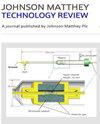Influence of Temperature and Orientation on Elastic, Mechanical, Thermophysical and Ultrasonic Properties of Platinum Group Metal Carbides
IF 2
4区 化学
Q4 CHEMISTRY, PHYSICAL
引用次数: 0
Abstract
The elastic, mechanical, thermophysical and ultrasonic properties of platinum group metal (PGM) carbides XC (X: Rh, Pd, Ir) have been investigated at room temperature. The Coulomb and Born-Mayer potential model has been used to compute second and third order elastic constants (SOECs and TOECs) at 0K and 300K. The obtained values of SOECs are used to evaluate the mechanical properties such as Young’s modulus, bulk modulus, shear modulus, Pugh’s indicator, Zener anisotropic constant and Poisson’s ratio at room temperature. The materials show the brittle nature as the value of Pugh’s indicator for PGM carbides has been achieved less than or nearly equal to 1.75. Again the values of SOECs are used to compute the ultrasonic velocities along <100>, <110> and <111> directions for the longitudinal and shear modes of wave propagation. Further the values of Debye temperature, thermal conductivity, specific heat per unit volume, energy density, average value of ultrasonic Grüneisen parameter, thermal relaxation time, non-linear parameter have been calculated with the help of SOECs, TOECs, ultrasonic velocities, density and molecular weight. Finally, the ultrasonic attenuation due to phonon-phonon interaction and due to thermoelastic relaxation mechanisms have been calculated with the use of all associated parameters. The calculated values of elastic, mechanical, thermophysical and ultrasonic properties are compared with available literature and discussed.温度和取向对铂族金属碳化物弹性、力学、热物理和超声性能的影响
研究了铂族金属(PGM)碳化物XC (X: Rh, Pd, Ir)在室温下的弹性、力学、热物理和超声性能。库仑和玻恩-梅耶势模型用于计算0K和300K时的二阶和三阶弹性常数(SOECs和TOECs)。利用得到的SOECs的力学性能,如杨氏模量、体积模量、剪切模量、Pugh指标、齐纳各向异性常数和泊松比在室温下进行了评价。PGM碳化物的Pugh指示值小于或接近等于1.75,材料表现出脆性。同样,超声声速的值被用来计算超声波沿波传播的纵向和剪切模式的速度和方向。利用SOECs、TOECs、超声速度、密度和分子量计算了Debye温度、导热系数、单位体积比热、能量密度、超声grisen参数平均值、热松弛时间、非线性参数。最后,利用所有相关参数计算了声子-声子相互作用和热弹性松弛机制引起的超声衰减。将弹性、力学、热物理和超声性能的计算值与现有文献进行了比较和讨论。
本文章由计算机程序翻译,如有差异,请以英文原文为准。
求助全文
约1分钟内获得全文
求助全文
来源期刊

Johnson Matthey Technology Review
CHEMISTRY, PHYSICAL-
CiteScore
4.30
自引率
4.30%
发文量
48
审稿时长
12 weeks
期刊介绍:
Johnson Matthey Technology Review publishes articles, reviews and short reports on science enabling cleaner air, good health and efficient use of natural resources. Areas of application and fundamental science will be considered in the fields of:Advanced materials[...]Catalysis[...][...]Characterisation[...]Electrochemistry[...]Emissions control[...]Fine and speciality chemicals[...]Historical[...]Industrial processes[...]Materials and metallurgy[...]Modelling[...]PGM and specialist metallurgy[...]Pharmaceutical and medical science[...]Surface chemistry and coatings[...]Sustainable technologies.
 求助内容:
求助内容: 应助结果提醒方式:
应助结果提醒方式:


